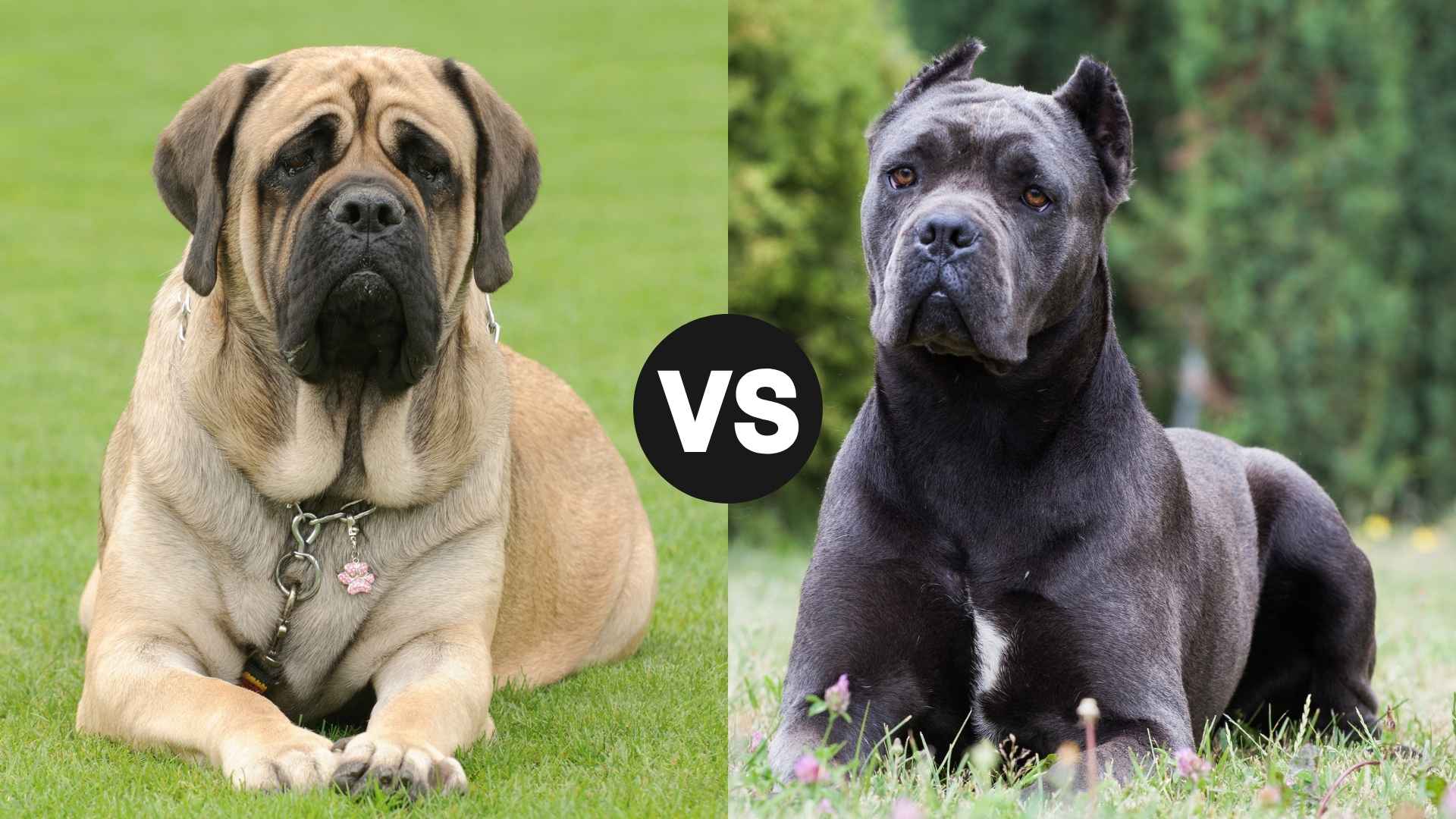If you’ve ever mistaken a Cane Corso for an English Mastiff, you’re definitely not alone. These two large and lovable breeds share a striking resemblance in general appearance, since both come from the ancient Molossian dog line. The Cane Corso, often called the Italian Mastiff, and the English Mastiff (usually just known as the Mastiff) are both loyal, affectionate, and intelligent companions.
But don’t let their similar looks fool you—there are some key differences to consider if you’re thinking of bringing one home. Though they’re closely related, the Cane Corso and the Mastiff were bred for very different roles, which shaped their personalities, energy levels, and even their size.
In this guide, we’ll break down the Mastiff vs Cane Corso debate to help you figure out which one might be the better fit for your lifestyle. Whether you want a protective guardian or a gentle couch potato, we’ve got you covered!
Mastiff vs. Cane Corso
Both the Mastiff and the Cane Corso share ancient Molossian roots, but their histories took unique paths. The English Mastiff, often simply called the Mastiff, has been around for over 2,000 years. Invaders of ancient Rome brought the Mastiff-type dogs to ancient Roman arenas, where it was made to battle bears, lions, tigers, bulls, other dogs, and even gladiators. In later years, the breed was also used in England’s bullbaiting and bearbaiting spectacles, according to Britannica.
These gentle giants came to North America on the Mayflower and are now cherished for their loyalty and calm demeanor. Despite their massive size and intimidating presence, their kind, wrinkled faces reveal their sweet, patient nature.
The Cane Corso, or Italian Mastiff, also descends from ancient war dogs but was primarily used as a watchdog, farmhand, and protector in rural Italy. Leaner and more athletic than the English Mastiff, the Cane Corso is also a giant dog that typically weighs over 100 pounds and stands up to 28 inches tall.
Known for their loyalty and protective nature, Corsi are powerful dogs that thrive with experienced handlers. While both breeds are protective and devoted, the Mastiff tends to be more mellow, whereas the Cane Corso is more energetic and work-driven, making each suited to different types of homes.
Mastiff vs. Cane Corso: Overall Comparison
The Mastiff and Cane Corso may share ancient Molossian roots, but their temperaments and energy levels set them apart. The Mastiff, often dubbed a gentle giant, is known for its calm and gentle temperament and super affectionate nature. Despite their history as arena fighters and great guard dogs, today’s Mastiffs have mellow and loving personalities and are often described as oversized lap dogs.
They have a massive and muscular build and are best suited for families seeking a low-energy, loyal companion who thrives in a relaxed home environment. Though they require early socialization, Mastiffs tend to get along well with small children and other pets when properly trained.
The Cane Corso, on the other hand, is more intense and work-driven. Muscular, intelligent, and naturally protective, this breed was historically bred to be a watchdog, farmhand, and even a battle dog. While affectionate with their families, Cane Corsos are wary of strangers and require consistent training, making them a better fit for experienced dog owners.
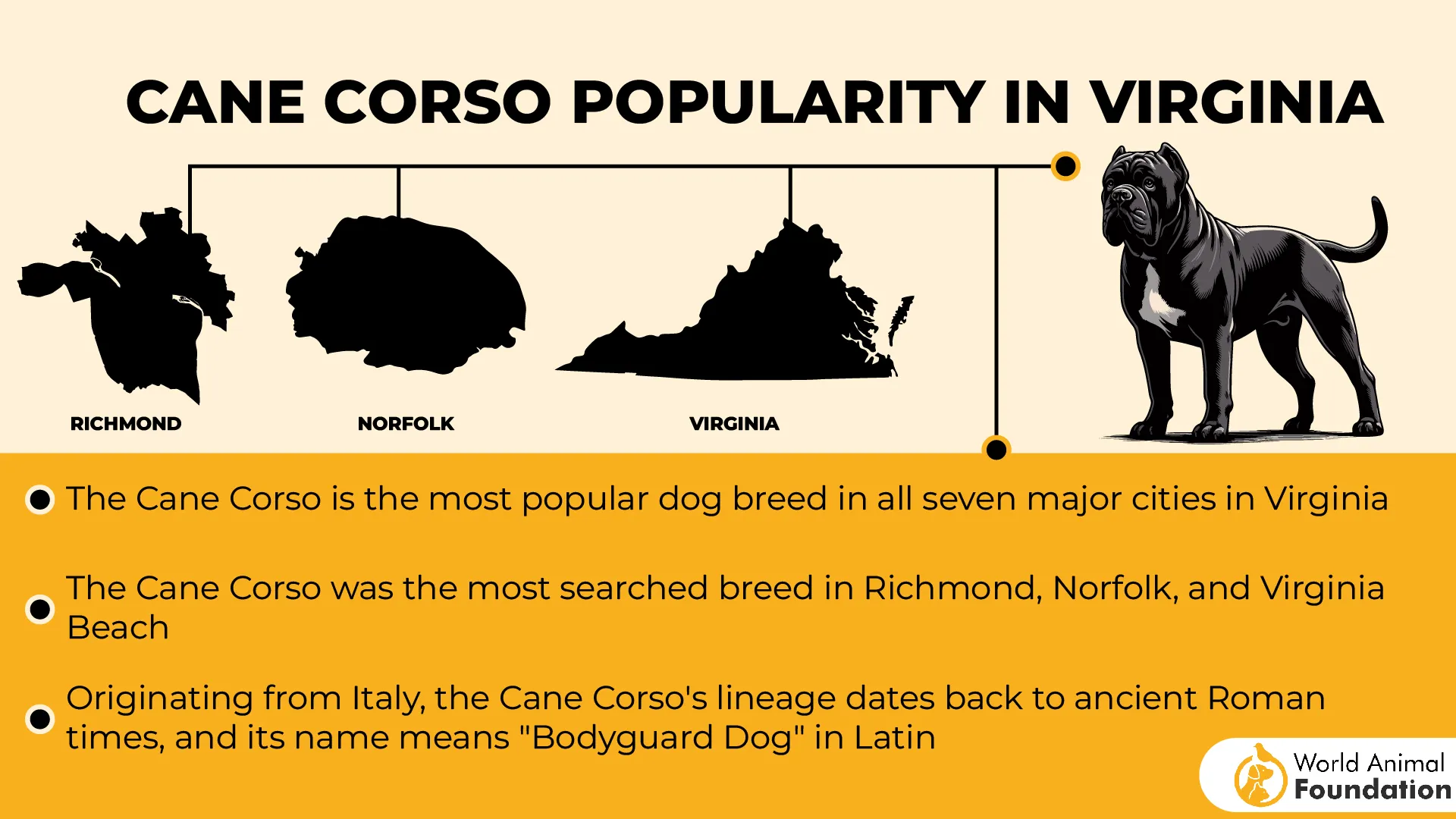
Their imposing appearance and strong guarding instincts can be misunderstood as aggression, but with early socialization, they become devoted, loyal protectors. Compared to the laid-back Mastiff, the Cane Corso is more active, alert, and suited for homes that can offer structure and leadership.
Size Differences Between Mastiff and Cane Corso
When it comes to sheer size, the Mastiff holds the title of one of the largest dog breeds in the world. Adult Mastiffs typically stand at least 27.5 inches tall, with males often reaching 30 inches or more. Their weight ranges widely from 120 to a hefty 230 pounds, and their build is thick, muscular, and imposing.
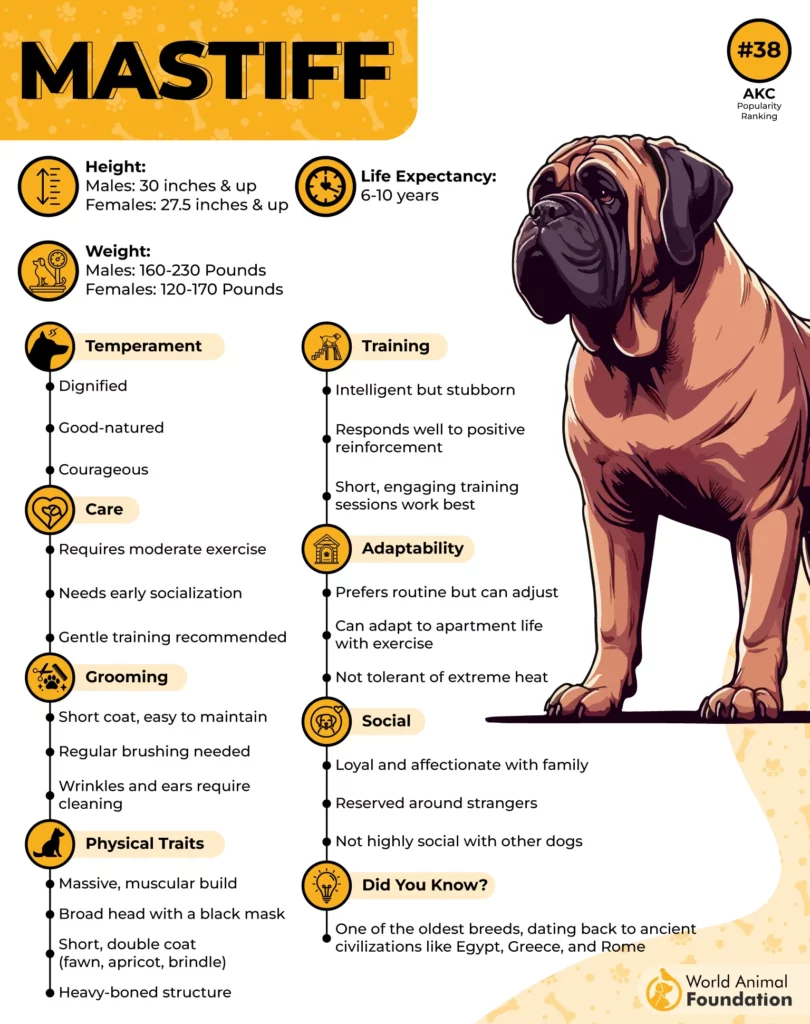
Despite their size, Mastiffs have gentle, soulful expressions framed by broad, wrinkled heads, short muzzles, and dark drooping ears. Their short, coarse coats come in shades like apricot, silver fawn, and brindled fawn and black.
The Cane Corso is slightly smaller but still a large and powerful breed. Standing up to 28 inches at the shoulder and weighing over 100 pounds, the Cane Corso is leaner and more athletic than the Mastiff.
These dogs have large, expressive heads, muscular frames, and short, stiff coats in colors like black, gray, fawn, red, or brindle. Tail docking and ear cropping are still common practices in some countries. While both breeds are impressive in stature, the Mastiff is broader and heavier, whereas the Cane Corso has a more agile and refined build.
Physical Appearance: Key Distinctions
The Mastiff has a massive, rectangular body with thick bones and broad muscles that emphasize its grandeur and power. Its wide, deep chest reaches to the elbows, and its strong neck supports an enormous head with a blunt muzzle that’s half the length of the skull. Small, v-shaped ears hang close to the cheeks, and the tail, set high, typically hangs straight down to the hocks.
The American Kennel Club (AKC) describes Mastiffs as “dignified, good-natured and courageous”. Their dignified, wrinkled expression paired with a somewhat clumsy gait that many owners find charming. Their short double coats come in shades of fawn, apricot, or brindle, and while other Mastiff types like the Tibetan Mastiff may have longer coats and lion-like ruffs, shedding is common across all varieties.
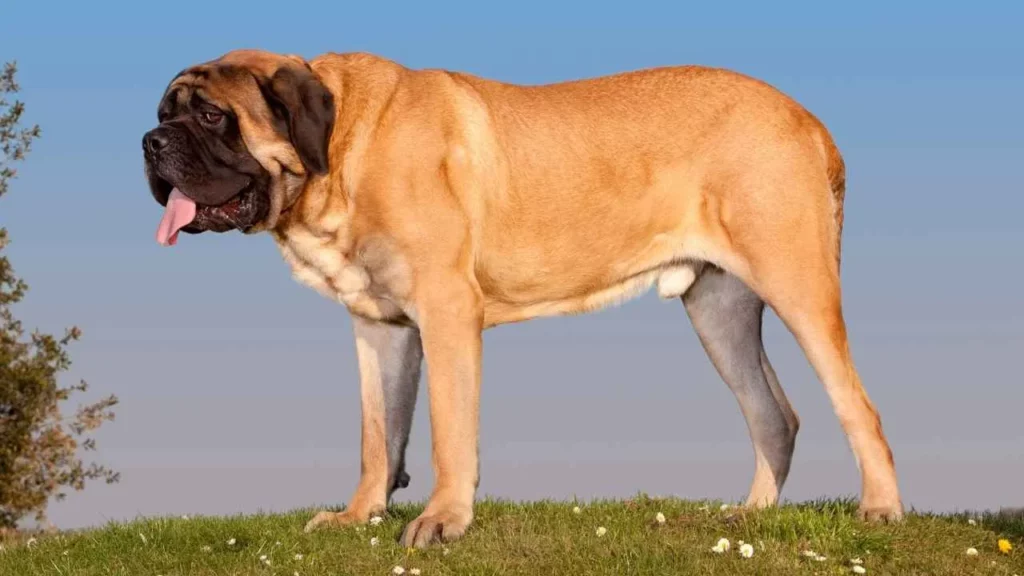
The Cane Corso, while also rectangular in shape, presents a more refined and athletic build. It has a muscular frame that allows for smooth, confident movement and a deep chest that reaches halfway down its body. Its large, squared head features a boxy muzzle and high-set ears, which are sometimes cropped, though it’s unnecessary.
The Cane Corso’s tail is thick and may be docked, but when left natural, it extends straight from the back and is carried low. This breed has a short, stiff coat that sheds less than a Mastiff’s and typically comes in black, gray, fawn, red, or brindle, with occasional white patches on the chest or lighter markings around the muzzle, states WebMD.
Temperament and Personality Traits
Mastiffs are gentle giants with a calm, affectionate demeanor and a deep devotion to their families. Despite their intimidating appearance, they are friendly and loving toward household members and often try to be oversized lapdogs. Their temperament is patient and easygoing, though they can be wary of strangers and make excellent watchdogs with a deep, purposeful bark.
Mastiffs tend to get along well with other pets if introduced early, but due to their size and strength, they may not be ideal for households with very young children or elderly individuals. They’re generally low-energy, prefer lounging over active play, and are more content as calm companions than jogging partners.
The Cane Corso has a serious, loyal, and watchful nature shaped by its working and guardian dog heritage. This breed is naturally protective and highly attentive, though moderately family-friendly. Its dominant instincts and strength require consistent training and socialization from a young age.
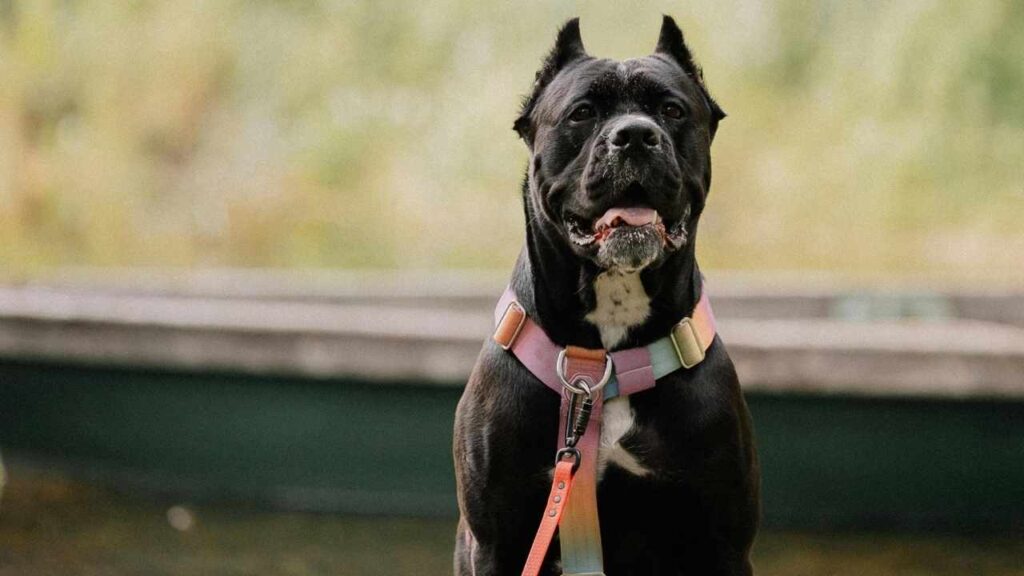
Cane Corsos are more independent and reserved than Mastiffs and may not be friendly toward strangers or other pets, especially those of the same sex. They may not be the ideal option for inexperienced owners as they do best in homes where their space and role are clearly defined. While affectionate with loved ones, Corsi are not overly playful or toy-driven and should always be supervised during interactions with kids or other animals.
Grooming Needs and Exercise Demands
Mastiffs have relatively low-maintenance grooming needs due to their short, dense coats, which typically require only a quick brushing a few times a week. However, during seasonal shedding periods, more frequent grooming with a toothed comb helps manage excess hair. Their facial wrinkles and ears should be regularly cleaned to prevent infections, and nail trims are essential.
One standout trait of Mastiffs is their tendency to drool heavily, making daily wipe-downs a routine part of care. Their massive size also demands soft bedding to prevent joint issues, a spacious living environment, and ample room in vehicles for transport.
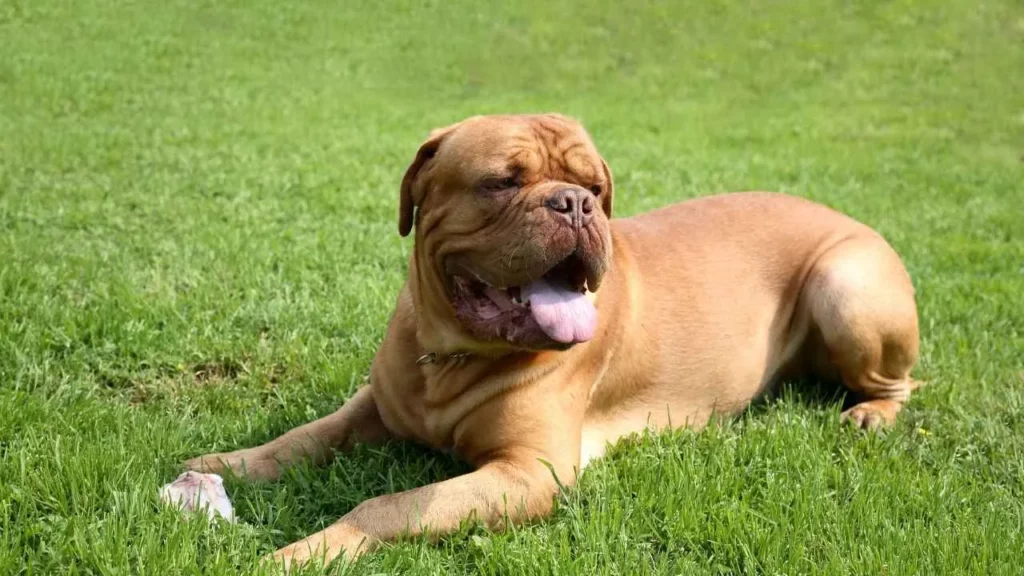
In contrast, the Cane Corso’s grooming requirements involve managing its short double coat, which sheds throughout the year and more heavily in spring. Weekly brushing—daily during shedding seasons—not only reduces loose hair but also promotes healthy skin and coat. In addition to regular grooming, they need regular exercise to stay fit.
These working dogs need at least 30 minutes to an hour of daily vigorous activity, such as long walks, runs, or play sessions. Without enough exercise and mental stimulation, they may become destructive. Ideal for active owners, Cane Corsos excel in dog sports and working roles and benefit from structured obedience training and engaging tasks to stay content and well-behaved.
Common Health Issues
Mastiffs, like many giant breeds, face several health challenges and have an average lifespan of 6–10 years. Common issues include hip dysplasia, progressive spinal disorders like degenerative myelopathy, and a range of eye conditions such as entropion, ectropion, cataracts, and progressive retinal atrophy, states PetMD.
They are also prone to serious diseases like epilepsy, various forms of cancer (e.g., osteosarcoma, lymphoma), and gastric dilatation-volvulus (bloat), a potentially fatal condition. Seasonal allergies and skin conditions are also frequent concerns. Early screening, responsible breeding, and regular vet check-ups can help manage these risks and improve quality of life.
Cane Corsos are prone to several hereditary health issues, including hip and elbow dysplasia, which can cause lameness and arthritis, and gastric dilatation-volvulus (bloat), a life-threatening condition common in large breeds.
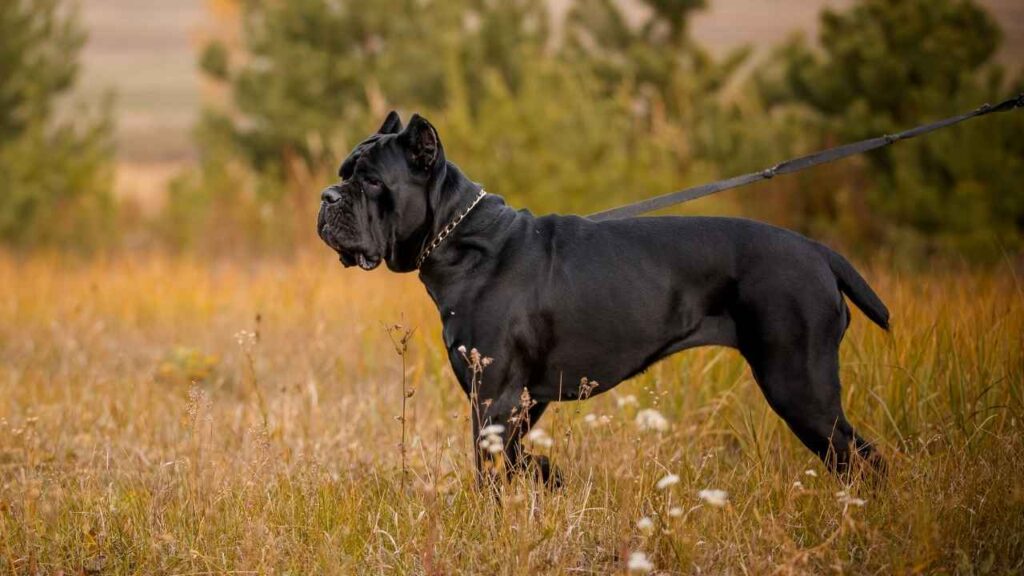
PDSA states that they may also suffer from eye anomalies, including cherry eyes, ectropion, where inward-rolling eyelids irritate the eyes, and idiopathic epilepsy, which typically presents with seizures between the ages of 2 and 5. Reputable breeders ensure veterinary screening and preventative care to manage and avoid these risks effectively. Additionally, regular check-ups and preventive care help the cane corso live a healthy life.
Conclusion
When comparing the Mastiff and Cane Corso, it’s clear that both breeds are loyal dogs with strong protective instincts, but they differ in energy levels, trainability, and ideal living situations. For first-time or inexperienced dog owners, the Mastiff, with its calm demeanour, moderate family-friendly nature, and minimal grooming needs, may be the better fit.
Cane Corsos, on the other hand, are highly trainable but require more structure, exercise, and early socialization to develop good behavior, making them better suited to experienced handlers.
These two dog breeds share a deep bond with their families and can become great family dogs with the right guidance. However, due to their size and temperament, neither is ideal for apartment living without significant daily exercise and attention.
Whether you’re drawn to the gentle giant nature of a Mastiff or the working drive of a Cane Corso, understanding your own lifestyle and experience level is key. With gentle training from an early age and regular care, both breeds can become proud additions to any pet-friendly home.


